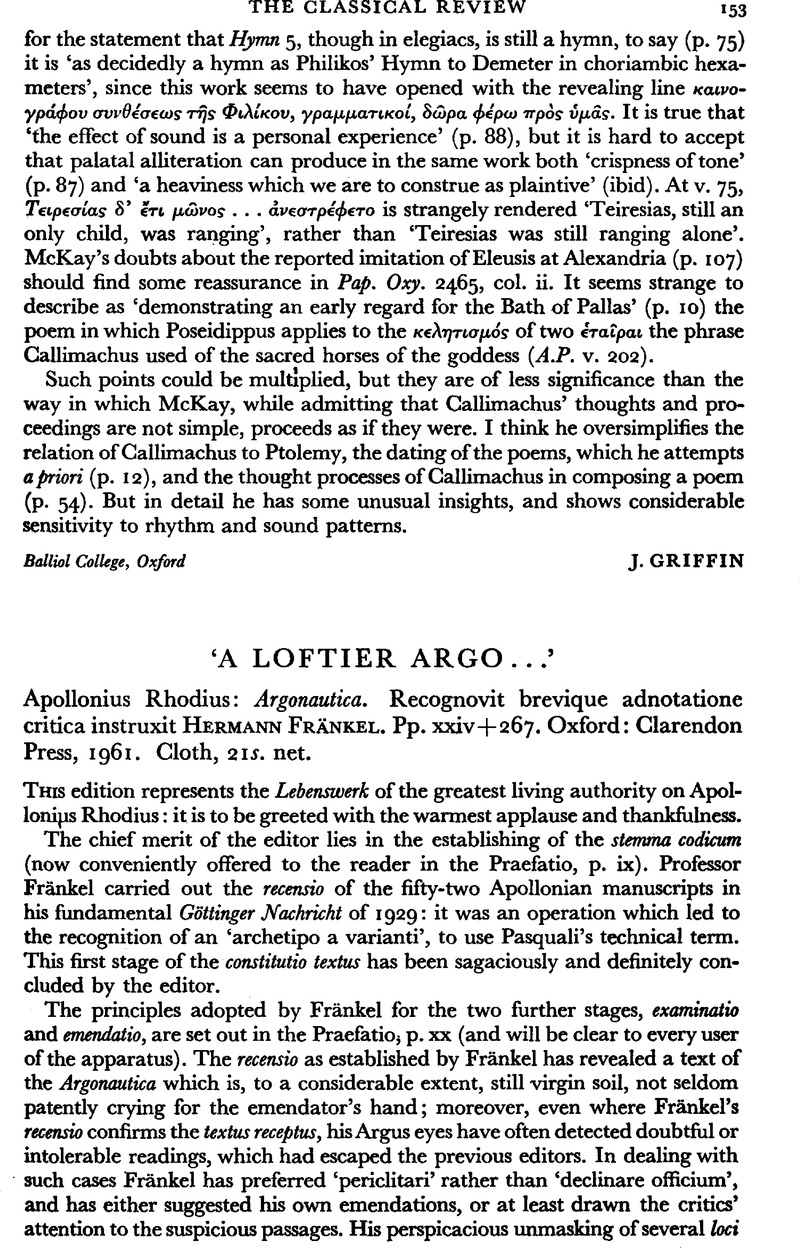No CrossRef data available.
Article contents
‘A Loftier Argo …’ - Apollonius Rhodius: Argonautica. Recognovit brevique adnotatione critica instruxit Hermann Fränkel. Pp. xxiv + 267. Oxford: Clarendon Press, 1961. Cloth, 21s. net.
Published online by Cambridge University Press: 27 February 2009
Abstract

- Type
- Reviews
- Information
- Copyright
- Copyright © The Classical Association 1963
References
page 154 note 1 Fränkel also complains (Praef., p. xviii) about the absence of a reliable concordance to the Argonautica: my learned friend A. F. Scholfield will soon fill this most serious gap.
page 154 note 2 Cf., e.g., iii. 801: τ⋯δε λωβ⋯εντα κα⋯ οὐκ ⋯νομαστ⋯ τελ⋯σσαι.
page 154 note 3 Mooney understands ‘for poets sing how Caeneus, though still alive, was slain by the Centaurs’: obviously they could only slay him when he was still alive (i.e. devant sa mort, to quote from the song on M. De La Palisse), and not when he was already dead, Such a text as accepted by Mooney is not only Lapalissian, but also untrue, because Caeneus, who was ἄτρωτος, was not slain by the Centaurs. The text clearly requires a statement in praise of Caeneus, but the wording ζω⋯ν περ…⋯λ⋯σθαι, with the ⋯λ⋯σθαι not negatived, does not meet such requirement.
page 155 note 1 In Aratus' passage the meaning is, as was rightly seen by the scholiasts (p. 441 Maas),⋯π⋯ση ⋯στ⋯ κλ⋯σις κα⋯ καμπ⋯ τ⋯νσκελ⋯ν κατ⋯ μ⋯νην τ ⋯ν τ⋯ν σκελ⋯ν καμπ⋯ν, but the expression is cleverly chosen in that it refers to the visible part of the καμπ⋯. The sense ‘as far as something extends’ is, of course, no less inherent in the verb περιφα⋯νομαι than the notion of seeing, περι- clearly denoting the margin of the thing seen. A pedantic, but accurate, translation of ὅσον περιφα⋯νεται would be ‘as far as something is seen to extend, to stretch’.
[PS. In Nic. Ther. 169 and Arat. Phaen. 517 ὅσσον (ὅσση) περιφα⋯νεται refers respectively to the length of a closed circular line (i.e. to the circumference of the snake) and of a semicircle (i.e. to the καμπ⋯); in Arat. Phaen. 830 τ⋯ μ⋯σσα means ‘the (solar) disk’ (cf. schol. on 820, τ⋯ μ⋯σον = disk, as opposed to the circumference, ⋯ κ⋯;κλῳ⋯ψ⋯ς; schol. on 830, τ⋯ μ⋯σον αὐτο⋯ = its disk, the sun's disk, as opposed to the beams) and περιφαε⋯νῃ means ‘appears in its circular contour’: we may conclude that, in Apollonius Rhodius, περιφα⋯νεται refers to the length of the semicircle appearing in a cross-section of the οὐρ⋯ς.]
page 156 note 1 Very clear in Gardthausen, Gr. Pal. 1, Tafel 6, letter χ, col. 11.




